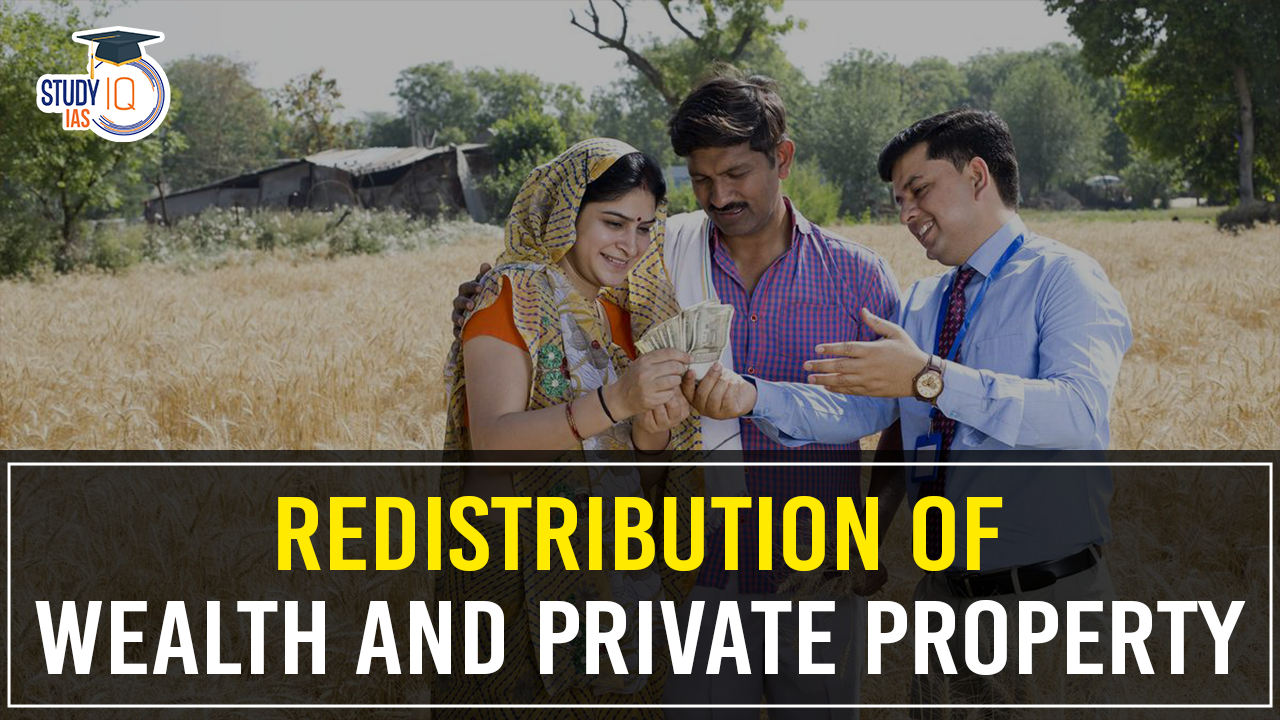Table of Contents
Context: A heated debate on wealth redistribution is taking centre stage in India’s ongoing election campaign.
The Constitution and Its Provisions
- The Constitution aims for social and economic justice through its Preamble and Directive Principles of State Policy (DPSP).
- DPSP are guidelines for achieving social and economic justice (i.e. not enforceable in courts, unlike the fundamental rights listed in Part III).
- Article 39(b) and (c) of the DPSP promote equitable distribution of resources and prevent wealth concentration.
Historical Context

- Originally, the right to property was a fundamental right (Article 19(1)(f)).
- The government could acquire private property with compensation (Article 31).
- Amendments (Articles 31A, 31B, 31C) aimed to give the government more flexibility to acquire land for public good due to limited resources.
- Supreme Court’s Interpretation:
- Court cases explored the relationship between fundamental rights and Directive Principles.
- Many cases challenged state amendments restricting the then-fundamental right to property.
- The Golak Nath case (1967) limited using Directive Principles to weaken fundamental rights.
- The Kesavananda Bharati case (1973) upheld a property right amendment (Article 31C) but allowed judicial review.
- The Minerva Mills case (1980) emphasised the Constitution’s balance between these rights and principles.
- Notably, the 44th amendment in 1978 removed the right to property from the list of fundamental rights, making it a legal right under Article 300A, which still mandates compensation for property acquisition but reduces direct litigation in the Supreme Court.
India’s Economic Policies Post-Independence
Early Economic Policies
- Socialist Model: In the first four decades after independence, India adopted a socialistic approach, enacting laws to redistribute wealth and reduce inequality.
- Land Acquisition: Laws were passed to acquire land from zamindars and large landowners for public purposes.
- Nationalisation and High Taxes: The government nationalised banking and insurance sectors and imposed high direct taxes, sometimes up to 97%, along with estate duties on inheritance and wealth taxes.
- Regulation of Private Enterprises: The Monopolies and Restrictive Trade Practices Act, 1969 (MRTP Act) was introduced to control the growth of private enterprises.
- Outcome: These measures aimed to redistribute wealth but often stifled economic growth and led to the concealment of income and wealth. The revenue from estate and wealth taxes was minimal compared to the administrative costs.
| Monopolies and Restrictive Trade Practices Act (MRTP Act) of 1969
● It was designed to prevent monopolistic and anti-competitive practices in the marketplace. ● It aimed to regulate and control unfair trade practices, restrictive trade practices, and the concentration of economic power to promote fair competition and protect consumer interests. |
Economic Reforms Post 1990
- Shift to Liberalisation: In the 1990s, India transitioned from a closed to a liberalised economy.
- New Industrial Policy: Introduced in July 1991, this policy aimed to empower market forces and improve the efficiency of the country’s industrial structure.
- Repeal of MRTP Act: Replaced by the Competition Act, 2002, alongside considerable reductions in income tax rates.
- Abolition of Estate Duty and Wealth Tax: Estate duty was abolished in 1985, and wealth tax followed in 2016.
Economic Outcomes and Current Inequality
- Reduction in Poverty: Liberalisation helped bring significant numbers of people out of abject poverty.
- Increase in Inequality: Despite these gains, inequality has grown.
- According to the World Inequality Lab, in 2022-23, the top 10% controlled 65% of wealth and 57% of income, while the bottom 50% held only 6.5% of wealth and 15% of income.
Current Political Debates and Legal Interpretations
- Congress Party’s Promises: The opposition Congress party has promised financial support of ₹1 lakh per annum to each woman from economically disadvantaged families.
- Rahul Gandhi’s Proposal: A financial survey to evaluate and address wealth distribution inequalities.
- Ruling Party’s Criticism: The ruling party has criticised these promises, suggesting that the opposition might reintroduce inheritance taxes that could affect poorer sections.
Supreme Court’s Involvement:
- The Supreme Court has formed a nine-judge bench to determine if private resources fall under Article 39(b) of the DPSP, which deals with the distribution of material resources to serve the common good.
The Way Forward: Balancing Growth and Equity
- Global Challenge: Rising inequality is a worldwide issue in market economies, not just in India.
- Government Responsibility: Protecting the poor, who rely heavily on the government, remains crucial.
- Past Policy Shortcomings: High taxes, estate duty, and wealth tax stifled growth and encouraged concealment of wealth.
- Balancing Act: Policies should promote innovation and economic growth while ensuring benefits reach marginalised groups.
- Policy Design: Open debate and well-designed policies, informed by current economic models, are essential.
- Ultimate Goal: Achieving economic justice for all, as promised by the Indian Constitution.


 Utkal Divas 2025: Odisha Foundation Day ...
Utkal Divas 2025: Odisha Foundation Day ...
 List of Military Exercises of India 2024...
List of Military Exercises of India 2024...
 GPS Spoofing and Its Impact in India: A ...
GPS Spoofing and Its Impact in India: A ...





















